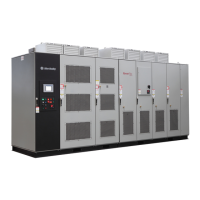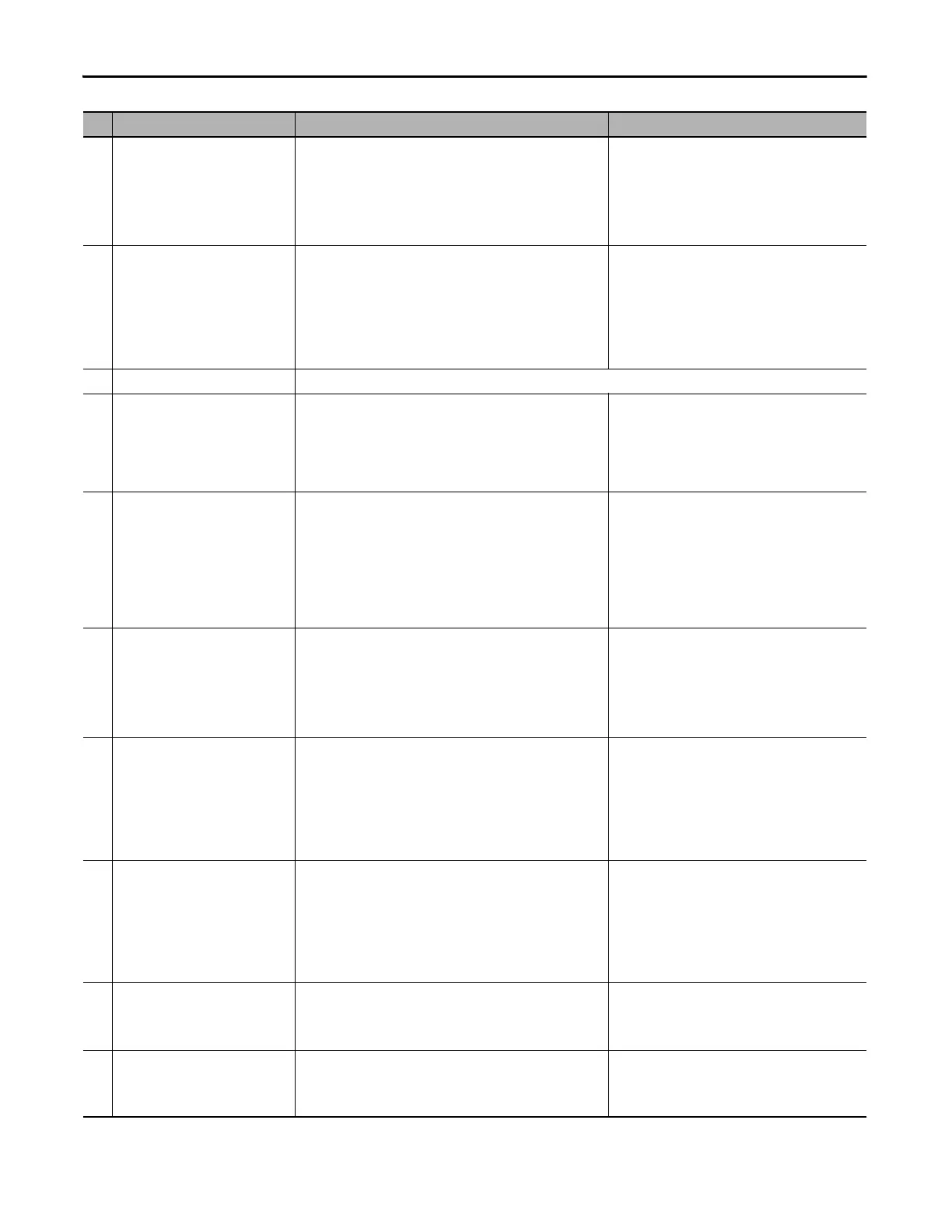202 Rockwell Automation Publication 6000-TD004D-EN-P - November 2017
Chapter 3 Fault Messages
5 Abnormal Output Voltage The voltage on the motor side, measured through the VSB, is different
from the rated voltage at some frequency point.
If the difference has exceeded the Over Voltage Deviation Fault
Threshold (P224) for the duration set in Filter Time for Abnormal Output
Voltage (P211), this fault will be reported over 20% rated frequency.
• Check parameters Output Voltage Deviation Fault
Threshold (P224) and Filter Time For Output Over
Voltage (P221) are set correctly.
• Verify the VSB, resistor, and wire are not damaged.
• Check hardware on the AT board.
• Check PWM board is working normally.
• Check terminals on the control box.
6 Ground Fault The drive has detected a ground fault. The voltage between neutral
and ground is measured through the VSB.
This fault occurs if the voltage has exceeded the Ground Fault Trip
Threshold (P230) for the duration set in Filter Time for Ground Fault
(P228). When the voltage is less than the threshold set in Ground Fault
Warning Cancellation Threshold (P256), this fault disappears.
• Check parameters Ground Fault Trip Threshold (P230)
and Filter Time for Ground Fault (P228) are set
correctly.
• Verify the VSB, resistor, and wire are not damaged.
• Check hardware on the AT board.
• Verify output cable grounding.
• Verify motor stator winding grounding.
• Perform the ground insulation test.
7 Over Speed Fault This fault is reserved.
8 Motor Stalled The drive cannot detect the motor speed. The fault condition is
calculated using frequency.
This fault occurs when the absolute deviation between the system
output frequency and output absolute frequency has exceeded the
Motor Stalled Fault Threshold (P238) for the duration set in Motor Stall
Fault Delay (P239).
• Verify if load exceeds motor torque.
• Check parameters Motor Stalled Fault Threshold (P238)
and Motor Stall Fault Delay (P239) are set correctly.
9 Output Phase Over Current The output current on the motor side is measured through the current
sensor in the power cell cabinet.
This fault occurs when the phase current has exceeded Phase Over
Current Threshold (P210) for the duration set in Phase Over Current Filter
Time (P209) with the frequency lower than Phase Over Current Enable
Frequency Range Upper limit (P208).
• Check the motor side (excluding the motor) for issues.
• Check parameters Phase Over Current Threshold (P210)
and Phase Over Current Filter Time (P209) are set
correctly.
•
Check parameter Low Speed Voltage Compensation
(P451) is set based on the motor. If it was not, the
output current should be higher.
• Check drive for output phase loss.
• Check hardware on the AT board.
10 VFD Over Current 1 The drive has detected an over load fault. The VFD over current
condition is calculated using the A, C phase stator current, transfer the
stator current to VFD current, and the algorithm based on the over
current trip (Heating Current Threshold (P110) and VFDOverload Current
(P080)) and the delay set in VFD Overload Time (P081).
• Verify the sensor in the cabinet is working.
• Check parameters Heating Current Threshold (P110),
VFD Rated Current (P085), Motor Rated Current (P199),
and VFDOverload Current (P080) are set correctly.
• Check hardware on the AT board.
• Overloading, verify the load in the field.
• Check internal motor for failure.
11 Fan Failure in Fan Group #2 The drive has tripped because the fans in transformer cabinet 2 are in
abnormal status for the duration set in Fan Control TX Cabinet Fan Fault
Trip Delay (P116).
In non-redundant fan mode (Fan Control Mode (P094) = 0), there are
one or more fans with abnormal status. In redundant fan mode (Fan
Control Mode (P094) = 1 or 2), there are two or more fans with
abnormal status.
• Check parameter Fan Control Redundant Fan Working
Time (P101) and set a greater value.
• Check parameter Fan Control Group #2 Fan Number
(P096) and verify the number of fans.
• Check operation of fans in transformer cabinet 2.
• Check the status of the fan feedback relay and
command execution relay. Both status should be
identical.
12 Pre-charge Contactor Failure This fault occurs if the status of the pre-charge contactor is changed
within the duration set in Pre-charge Feedback Delay (P104).
• Check parameter Pre-charge Feedback Delay (P104) is
set correctly. There should be sufficient time for the
pre-charge contactor to execute the command and
the feedback signal to be sent to the control box.
• Check if the pre-charge contactor is available.
• Check the status of the pre-charge contactor indicator
light and the light on the DT board. Both status should
be identical.
13 Pre-charge Timeout The pre-charge duration has exceeded Pre-charge Max Time (P118). • Check parameter Pre-charge Max Time (P118) is set
correctly.
• Check pre-charge resistor and capacitor of power cell.
• Check line side voltage feedback.
14 Pre-charge Repeat Interval Low The pre-charge repeat interval is less than Pre-charge Min Repeat
Interval (P119).
• Check parameter Pre-charge Min Repeat Interval
(P119)
is set correctly.
• Check if operator performed the pre-charge interval
earlier than Pre-charge Min Repeat Interval (P119).
No. System Fault Message Description Recommended Action(s)

